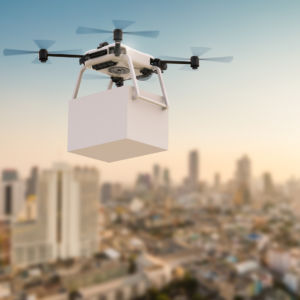New drone technologies that can put packages directly into the hands of customers represent the latest breakthrough for consumer delivery and bring to mind a future dotted with unmanned aircraft dropping packages from the sky. But these advancements also raise questions about how policymakers will address pressing safety, infrastructure and social concerns and allow these technologies to benefit all Americans and the entire economy.
As consumers shift from centuries of going to market to an expectation that the market will come to them, the quandary of efficient and cost-effective last-mile delivery has become a priority for the retail industry. It was only a few years ago that consumers were amazed they could order a product online on Monday and have it by Friday. Now, that expectation has shrunk to 24 hours, and forward-thinking retailers are furiously competing to be the first to offer delivery consistently within hours of purchase.
Enter the drone. Technology, as is the case in countless aspects of today’s society, holds the key to unlocking the solution that has vexed traditional retailers for years. Namely, how to meet consumer demand that has moved away from the in-store experience to the convenience of shopping from your couch. By any measure, the technology has progressed at a rapid pace, and with experts predicting that drone delivery will be ubiquitous in just a matter of years, lawmakers must start considering policies that will shape this future.
But, as we know, government often finds itself in reaction mode when it comes to innovation while struggling to play the role of proactive futurist — largely because policymaking bodies are designed to be deliberative and reactive. Policymakers surely could not have dreamed drones with the ability to deliver from the sky coming so quickly, and as technology develops at an unprecedented rate, our policy system may also need an upgrade — or at least a new mindset — to create a regulatory environment that can adapt to these changes.
A recent study by the U.S. Postal Service showed a stark divide between Americans living based on their geographical distinction, with urban residents significantly more receptive to the concept of the drone delivery than their counterparts in the suburban areas. Rural and suburban groups were also more fearful of malfunctions with drone delivery.
What does that mean for city planners and policymakers, not to mention residents and taxpayers? While fewer rural residents have embraced the idea of drone delivery, consumer demand may outweigh any initial discomfort when it comes to drones. But during the time that it takes for neighborhoods to warm to drone delivery, policymakers must consider steps they can take today to maximize the future benefits of drones in their communities.
For instance, the Federal Aviation Administration’s “line of sight” rule, which prohibits drone operation beyond the operator’s visibility, threatens to apply the brakes to the drone delivery conversation. Delivery companies such as UPS and retailers like Amazon are constantly researching new options and drone technology deployment, and consumers would undoubtedly benefit as long as they can maintain access to a truly free market. But for this to become a reality, policymakers will need to think about modernizing existing rules that create barriers to widely deploying this technology.
And with real estate at a premium in most urban centers — and as more downtowns experience renaissances and double-digit population growth — issues such as traffic jams and market access become more prominent. Regulations that allow drones delivery to ease these congestions while maintaining the flexibility that traditional delivery services provide will ensure that the needs of consumers, retailers and residents are addressed.
As innovation continues to reshape our economy and the way nearly all Americans live, the time is now for policymakers to think as futurists. A good rule of thumb for policymakers to remember is to keep the interest of the consumer — and, by default, their taxpaying constituents — in the forefront as they try their hand at predicting the future.

